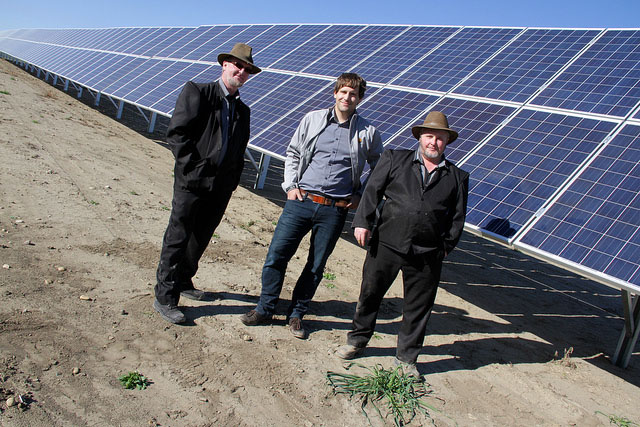The Green Acres Hutterite colony, on its 20,000 acres in southeastern Alberta, manages a number of farming operations, a plastics recycling facility, and the largest solar farm in Western Canada. David Dodge described his visit to the colony and its extensive solar project in a piece published in the Huffpost Alberta Canada last week.
Mr. Dodge is met at the colony by the financial boss, Dan Hofer, and his brother, Jake Hofer, the colony electrician. After lunch—colony residents eat breakfasts and suppers communally, but they have their mid-day meals in their own homes—the men, plus David Vonesch, the CEO of SkyFire Energy which installed the solar system, go out to tour the facility .

It consists of 7,600 solar modules, many rows of them in a field, all of course facing south and generating 2 megawatts of power. Jake Hofer expresses his amazement at the fact that they all sit there quietly harvesting energy, with no moving parts. “It still blows me away to this day,” he says.
Dan Hofer links their installation of the solar system quite firmly to the basic Hutterite ways of doing things. They installed the solar project for the purely economic reason that over the long term it is sensible. He compares it to planting potatoes.
They calculated the initial investment—4.8 million dollars Canadian—added up the figures, and saw that in the long-term the results would be beneficial. If you grow your own meat and vegetables and rely on your own garden, then harvesting solar energy falls in the same category. He feels that it reflects the spirit of depending on your own resources rather than on someone else’s. He adds that it is also certainly good for the environment.
Mr. Vonesch, from SkyFire Energy, says that the solar resource itself is better in that part of Alberta than anywhere else in Canada. Wind energy is also plentiful in Alberta, and it is the choice of the Pincher Creek colony in the same province. But Jake feels that the issue of maintenance for the wind plants would be more of a problem than it would be for a solar system. And, he admits, he’s scared of the heights of the wind turbines.
The colony calculated that at the current price of electricity, they will have a financial payback in about 15 years, and even sooner if the costs of electric power go up.
Mr. Dodge notes that some First Nations people were also at the colony investigating the value of going solar when he was visiting. Mr. Vonesch tells him that the initiative taken at Green Acres has increased the interest of Canadians for possibly following the same route. He said that Ontario has moved far ahead of Alberta in installing solar power, and that that province has now ended coal-fired generating plants. Mr. Dodge concludes his article by reflecting that the colony’s initiative will help Canada nibble away at its greenhouse gas emissions.
Further information about the solar installation at the colony, and numerous photos, can be found on the SkyFire Energy website.